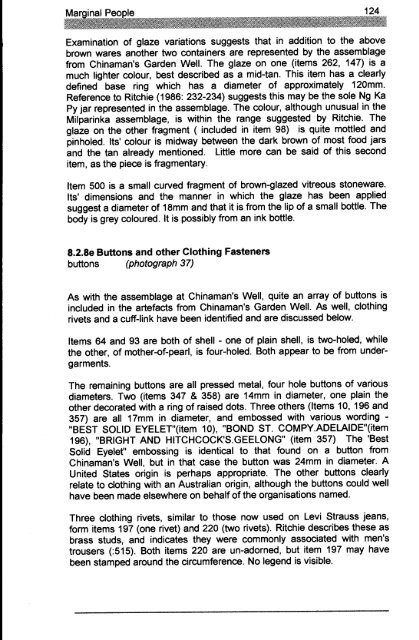Adec Preview Generated PDF File - The Sydney eScholarship ...
Adec Preview Generated PDF File - The Sydney eScholarship ...
Adec Preview Generated PDF File - The Sydney eScholarship ...
You also want an ePaper? Increase the reach of your titles
YUMPU automatically turns print PDFs into web optimized ePapers that Google loves.
Examination of glaze variations suggests that in addition to the above<br />
brown wares another two containers are represented by the assemblage<br />
from Chinaman's Garden Well. <strong>The</strong> glaze on one (items 262, 147) is a<br />
much lighter colour, best described as a mid-tan. This item has a clearly<br />
defined base ring which has a diameter of approximately 120mm.<br />
Reference to Ritchie (1986: 232-234) suggests this may be the sole Ng Ka<br />
Py jar represented in the assemblage. <strong>The</strong> colour, although unusual in the<br />
Milparinka assemblage, is within the range suggested by Ritchie. <strong>The</strong><br />
glaze on the other fragment ( included in item 98) is quite mottled and<br />
pinholed. Its' colour is midway between the dark brown of most food jars<br />
and the tan already mentioned. Little more can be said of this second<br />
item, as the piece is fragmentary.<br />
Item 500 is a small curved fragment of brown-glazed vitreous stoneware.<br />
Its' dimensions and the manner in which the glaze has been applied<br />
suggest a diameter of 18mm and that it is from the lip of a small bottle. <strong>The</strong><br />
body is grey coloured. It is possibly from an ink bottle.<br />
8.2.8e Buttons and other Clothing Fasteners<br />
buttons (photograph 37)<br />
As with the assemblage at Chinaman's Well, quite an array of buttons is<br />
included in the artefacts from Chinaman's Garden Well. As well, clothing<br />
rivets and a cuff-link have been identified and are discussed below.<br />
Items 64 and 93 are both of shell - one of plain shell, is two-holed, while<br />
the other, of mother-of-pearl, is four-holed. Both appear to be from undergarments.<br />
<strong>The</strong> remaining buttons are all pressed metal, four hole buttons of various<br />
diameters. Two (items 347 & 358) are 14mm in diameter, one plain the<br />
other decorated with a ring of raised dots. Three others (Items 10, 196 and<br />
357) are all 17mm in diameter, and embossed with various wording <br />
"BEST SOLID EYELET"(item 10), "BOND ST. COMPY.ADELAIDE"(item<br />
196), "BRIGHT AND HITCHCOCK'S.GEELONG" (item 357) <strong>The</strong> 'Best<br />
Solid Eyelet" embossing is identical to that found on a button from<br />
Chinaman's Well, but in that case the button was 24mm in diameter. A<br />
United States origin is perhaps appropriate. <strong>The</strong> other buttons clearly<br />
relate to clothing with an Australian origin, although the buttons could well<br />
have been made elsewhere on behalf of the organisations named.<br />
Three clothing rivets, similar to those now used on Levi Strauss jeans,<br />
form items 197 (one rivet) and 220 (two rivets). Ritchie describes these as<br />
brass studS, and indicates they were commonly associated with men's<br />
trousers (:515). Both items 220 are un-adorned, but item 197 may have<br />
been stamped around the circumference. No legend is visible.




